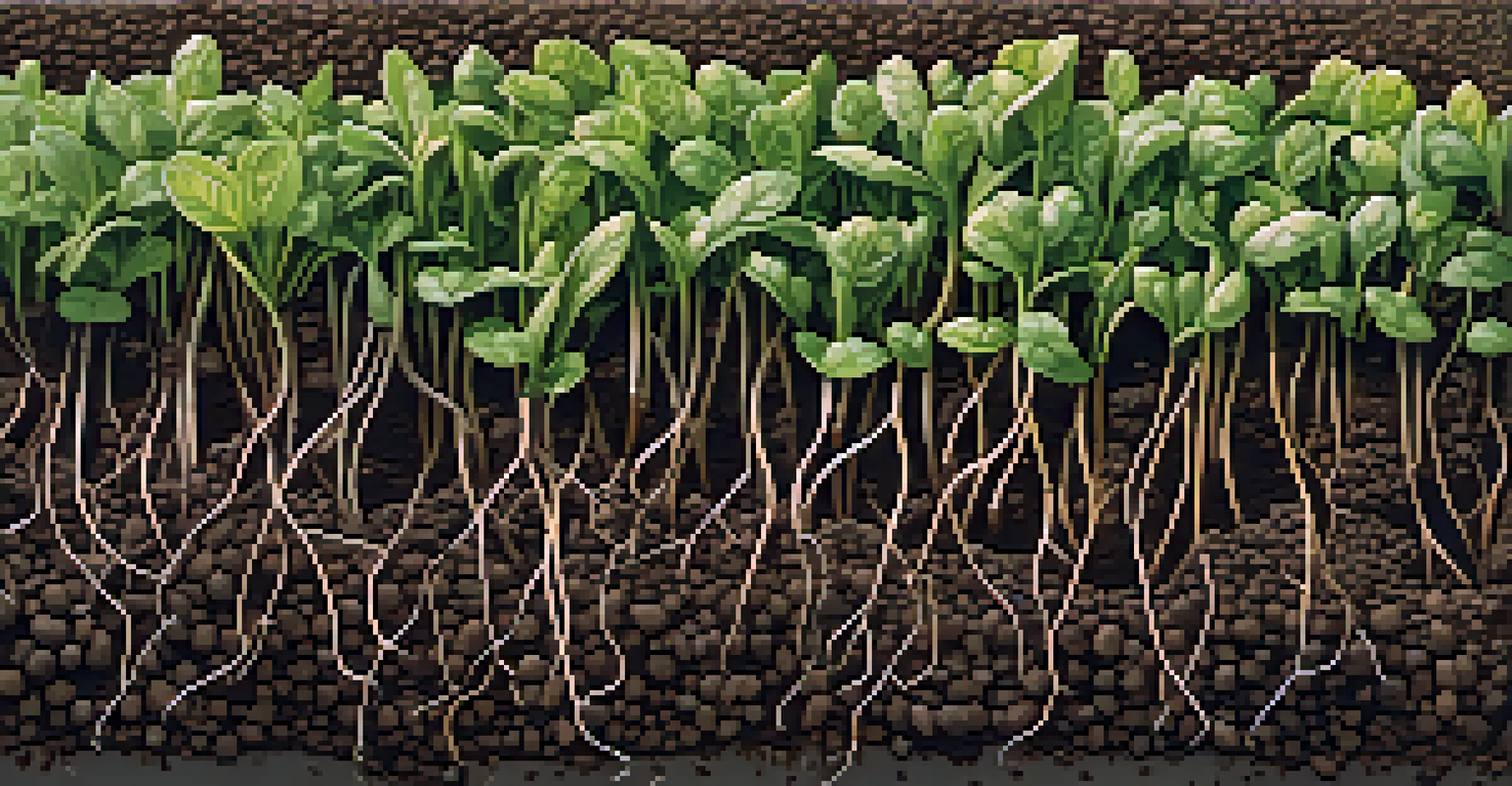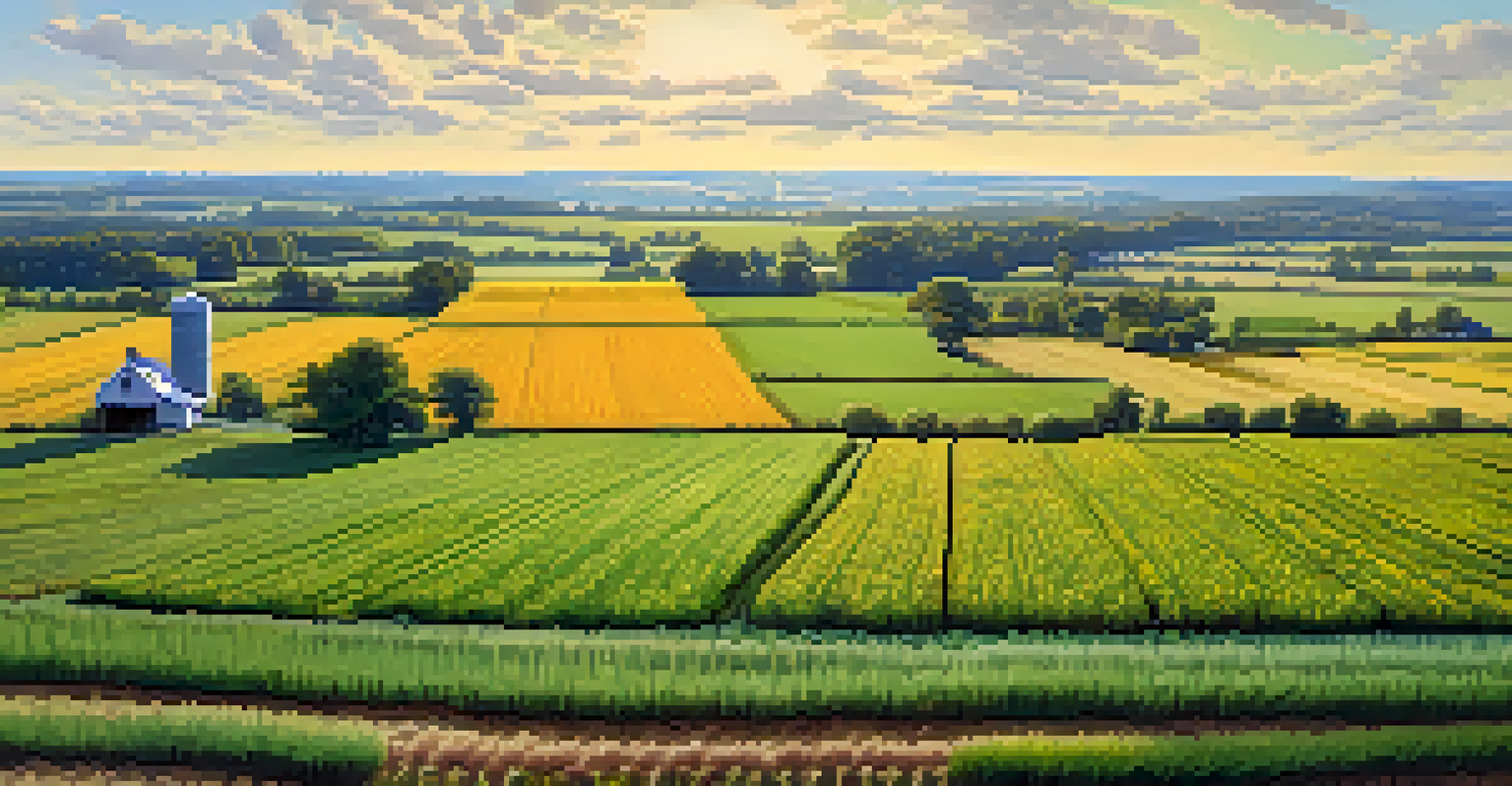Using Cover Crops for Soil Health and Climate Resilience

Understanding Cover Crops and Their Importance
Cover crops are plants grown primarily to improve soil health rather than for harvest. They play a crucial role in enhancing soil structure, increasing organic matter, and preventing erosion. By planting these crops during off-seasons, farmers can ensure that their fields are never left bare, which is vital for maintaining soil vitality.
Healthy soil is the foundation of a healthy food system.
These crops, such as clover, rye, and vetch, contribute to a healthier ecosystem by providing nutrients back to the soil and supporting beneficial microorganisms. They act like a natural sponge, capturing moisture and reducing runoff, which is increasingly important in the face of climate change. The importance of cover crops extends beyond just soil; they also contribute to farm resilience and sustainability.
Incorporating cover crops into agricultural practices can significantly influence long-term productivity. By enhancing soil health, farmers can reduce dependency on chemical fertilizers and pesticides, leading to a more sustainable farming model. This shift not only benefits the environment but also improves the bottom line for farmers.
The Role of Cover Crops in Soil Health
Cover crops are often referred to as 'nature's soil protectors.' They help prevent soil erosion by stabilizing the soil with their root systems, which is particularly important on slopes or during heavy rains. Additionally, these plants protect the soil surface from the harsh impact of raindrops, which can displace soil particles and lead to erosion.

Moreover, cover crops contribute to soil fertility by fixing nitrogen and adding organic matter as they decompose. For example, legumes like peas and beans can enrich the soil with nitrogen, a critical nutrient for plant growth. This natural fertilization reduces the need for synthetic fertilizers, promoting a healthier ecosystem.
Cover Crops Enhance Soil Health
Cover crops improve soil structure, increase organic matter, and prevent erosion, contributing to a healthier agricultural ecosystem.
Healthy soil teems with life, including earthworms and beneficial bacteria, which are essential for nutrient cycling. Cover crops foster this biodiversity by providing habitats and food sources for these organisms. As a result, the soil becomes more resilient to pests and diseases, creating a more balanced agricultural environment.
Enhancing Climate Resilience with Cover Crops
Climate change poses significant challenges to agriculture, but cover crops can help mitigate these effects. By improving soil structure and increasing moisture retention, cover crops can enhance a farm's ability to withstand drought conditions. This resilience is vital as weather patterns become increasingly unpredictable.
The best way to predict the future is to create it.
Additionally, cover crops can sequester carbon in the soil, contributing to efforts to combat climate change. By capturing carbon dioxide from the atmosphere and storing it underground, these crops help reduce greenhouse gas emissions. For farmers, this means they can play an active role in addressing climate issues while maintaining their productivity.
Furthermore, cover crops can buffer against extreme weather events, such as heavy rainfall or floods. Their extensive root systems help absorb excess water, reducing runoff and soil erosion. In this way, cover crops serve as a protective layer, offering a sustainable approach to managing the impacts of climate change on agriculture.
Choosing the Right Cover Crops for Your Farm
Selecting the appropriate cover crops involves considering several factors, including climate, soil type, and the specific goals of your farming operation. For instance, if you're in a colder climate, winter rye may be an excellent choice due to its hardiness. On the other hand, if your focus is on improving nitrogen levels, legumes like clover may be the way to go.
It's also essential to think about the timing of planting and termination of cover crops. Ideally, you'll want to plant them early enough to establish a strong root system before the main growing season. Understanding the growth cycles of different cover crops can help you maximize their benefits without interfering with your primary crops.
Boosting Climate Resilience
By improving soil structure and moisture retention, cover crops help farms withstand drought and mitigate the effects of climate change.
Involving local agricultural extension services can provide valuable insights tailored to your region. They can recommend which cover crops have thrived in similar conditions and help you devise a plan that aligns with your farm's overall strategy. Making informed choices will ultimately lead to better outcomes for both your soil health and your harvest.
Integrating Cover Crops into Your Farming Practices
Integrating cover crops into your existing farming practices may seem daunting, but it can be done gradually. Start small by dedicating a portion of your land to cover crops and assess their impact on soil health and crop yields. This trial-and-error approach allows you to learn and adapt without overwhelming your current systems.
Furthermore, consider incorporating cover crops as part of a crop rotation strategy. Rotating cover crops with cash crops can break pest cycles and improve soil fertility. For example, following a corn crop with a cover crop like sorghum-sudangrass can enhance soil health while providing a habitat for beneficial insects.
Networking with other farmers who have successfully integrated cover crops can provide additional insights and support. Learning from their experiences can help you overcome potential challenges and make the transition smoother. Remember, each farm is unique, and finding what works best for you is key.
Measuring the Benefits of Cover Crops
To truly appreciate the impact of cover crops, it's essential to measure their benefits over time. This can involve monitoring soil health indicators such as organic matter content, nutrient levels, and microbial activity. Regular soil testing can provide valuable data and help you understand how cover crops are enhancing your soil.
In addition to soil health, tracking crop yields before and after implementing cover crops can provide insight into their effectiveness. Many farmers report increased yields and improved crop quality after adopting cover crops. This not only demonstrates the value of cover crops but can also lead to better financial outcomes.
Choosing the Right Cover Crops
Selecting appropriate cover crops based on climate and soil type is crucial for maximizing their benefits and enhancing farm productivity.
Finally, documenting your experiences can help you refine your approach and share valuable insights with others. Whether through blogs, social media, or local farmer meetings, sharing your journey can inspire others to consider cover crops as a viable option for improving soil health and climate resilience.
The Future of Agriculture with Cover Crops
As the agricultural landscape continues to evolve, the role of cover crops will become increasingly important. With growing concerns about soil degradation, climate change, and food security, integrating cover crops into farming practices offers a sustainable path forward. They not only enhance soil health but also contribute to broader environmental goals.
The future of agriculture will likely see a shift toward more regenerative practices, with cover crops at the forefront. Innovations in technology and research will continue to uncover new ways to optimize the benefits of cover crops, making them even more accessible to farmers. This could lead to a more resilient and sustainable food system for future generations.

Ultimately, the adoption of cover crops represents a commitment to stewardship of the land. By prioritizing soil health and climate resilience, farmers can ensure their operations thrive while contributing positively to the environment. Together, we can cultivate a future where agriculture and nature work hand in hand.